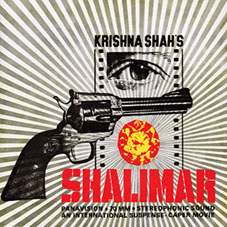Gangsters on DVD
“Gangsters is arguably the most unusual series ever shown on British television. Produced by BBC Pebble Mill between 1975 and 1978, what began as a tough and uncompromising attempt to depict Birmingham’s underworld had by the end of its run become a fully fledged work of…what?”
What indeed… Along with The Prisoner, my favourite British TV series. Patrick MacGoohan and Rover have the edge but Gangsters was still something else, the product of a period when the BBC was actively encouraging experimentation and the pushing of dramatic boundaries. Pulpy, trashy, provocative, thrilling and, in the later episodes, downright surreal… Hard to believe now that this was primetime viewing; British television was a unique place in the 1970s.
Sandy Denny
 “We don’t hear Sandy Denny on the radio these days. Her records, few that they are, don’t fit the current formats, don’t send the programmers into paroxysms, don’t have listeners voting in. She couldn’t be considered for Sixties, Seventies hit nostalgia; she never had hits. Rock album stations? Never sold enough albums. Even Nick Drake sneaks into the odd Easy Listening show, the music lulling and deceiving, with its attractive surfaces hiding the pain within, something romantic for a cult to cling to. But where is Sandy’s cult? Where are the graveside vigilants à la Jim Morrison? The colour supplemental cultural dissections? The South Bank Show eulogies, the bad TV- and film-biopics telling us who should be important in our lives? Somewhere the taste gurus have failed the flock, have failed to tell us, after twenty years of hindsight opportunity, that Sandy Denny was the greatest British female artist of her generation.”
“We don’t hear Sandy Denny on the radio these days. Her records, few that they are, don’t fit the current formats, don’t send the programmers into paroxysms, don’t have listeners voting in. She couldn’t be considered for Sixties, Seventies hit nostalgia; she never had hits. Rock album stations? Never sold enough albums. Even Nick Drake sneaks into the odd Easy Listening show, the music lulling and deceiving, with its attractive surfaces hiding the pain within, something romantic for a cult to cling to. But where is Sandy’s cult? Where are the graveside vigilants à la Jim Morrison? The colour supplemental cultural dissections? The South Bank Show eulogies, the bad TV- and film-biopics telling us who should be important in our lives? Somewhere the taste gurus have failed the flock, have failed to tell us, after twenty years of hindsight opportunity, that Sandy Denny was the greatest British female artist of her generation.”
Richard Thompson
Shalimar by Rahul Dev Burman

Shalimar (1978) by the incredibly prolific RD Burman.
Fabulous soundtrack for a crazy Bollywood movie.
01 Title Music 2:51
02 One Two Cha Cha Cha 5:36
03 Hum Bewafa Hargiz Na Thay 4:11
04 Countess Caper (Music) 3:51
05 Naag Devta 4:19
06 Aaina Wohi Rehta Hai 6:28
07 Baby Let’s Dance Together 2:34
08 Romantic Theme (Music) 2:33
09 Mera Pyar Shalimar 4:46
10 Hum Bewafa Hargiz Na Thay (Happy) 2:03



